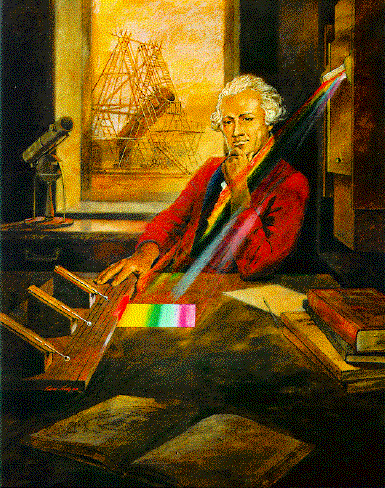Herschel Discovers Infrared Light

Sir Frederick William Herschel (1738-1822) was
born in Hanover, Germany, and became well-known as both a musician and
an astronomer. He emigrated to England in 1757 and, with his sister
Caroline, constructed telescopes to survey the night sky.
Their work resulted in several catalogs of double stars and nebulae.
Herschel is perhaps most famous for his discovery
of the planet Uranus in 1781, the first new planet found since antiquity.
In the year 1800, Herschel made another important discovery.
He was interested in learning how much heat passed through the different
colored filters he used to observe the Sun and noticed that filters of
different colors seemed to pass different levels of heat. Herschel
thought that the colors themselves might contain different levels of heat,
so he devised a clever experiment to investigate his hypothesis.
Herschel directed sunlight through a glass prism to create a spectrum -
the "rainbow" created when light is divided into its colors - and
measured the temperature of each color.
He used three thermometers with blackened bulbs (to better
absorb the heat) and, for each color of the spectrum,
placed one bulb in a visible color while the other two
were placed beyond the spectrum as control samples. As he measured the
temperatures of the violet, blue, green, yellow, orange and red light, he noticed
that all of the colors had temperatures higher than the controls and that
the temperature of the colors increased from the violet to the red part
of the spectrum. After noticing this pattern, Herschel decided to measure
the temperature just beyond the red portion of the spectrum in a region
apparently devoid of sunlight. To his surprise, he found that this region
had the highest temperature of all.
Herschel performed further experiments on what he called "calorific rays"
(derived from the Latin word for 'heat')
beyond the red portion of the spectrum. He found that they were
reflected, refracted, absorbed and transmitted just like visible light.
What Sir William had discovered was a form of light (or radiation)
beyond red light. These "calorific rays" were later renamed infrared rays
or infrared radiation (the prefix infra means `below').
Herschel's experiment was important not only because it led to the
discovery of infrared light, but also because it was the first time that
someone showed that there were forms of light that we cannot see with
our eyes.
Recent developments in detector technology have led to many useful applications
using infrared radiation.
Medical infrared technology is used for the non-invasive analysis of body tissues
and fluids.
Infrared cameras are used in police and security work as well as in
the military. In fire fighting, infrared cameras are used to locate
people and animals caught in heavy smoke and for detecting hot spots in fires.
Infrared imaging is used to detect heat loss in
buildings, in the testing of electrical and mechanical systems, and in pollution
control.
Infrared satellites have been used to monitor the Earth's weather, to study
vegetation patterns, and to study the distribution of rocks, minerals and soil.
Infrared satellites are also used to measure ocean temperatures. For example, infrared
satellite imagery showed the immense strength of the most recent El Nino.
Thermal infrared imaging has also been used to discover hundreds of miles of ancient
roads and footpaths providing valuable information to archeologists.
In the field of infrared astronomy, new and fascinating discoveries are
being made about the Universe. The Universe is dusty and one way to peer into the
obscured cocoons of star formation and into the hearts of dusty galaxies is
with penetrating infrared telescopes.
Since our universe is expanding, as a result of the Big Bang, the visible
light emitted by very distant objects in space is "doppler/red-shifted"
into the infrared portion of the spectrum by the time it reaches us, making
it detectable only in the infrared.